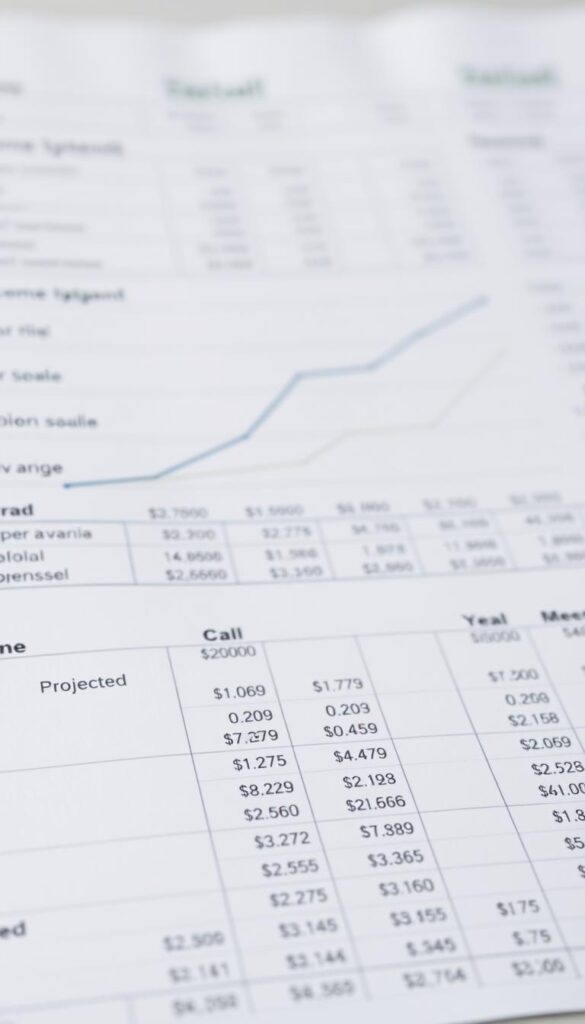Do you know how a 3-statement financial model can change your company’s future? In today’s fast world, knowing how to make a 3-Statement Financial Model is key. It combines your income statement, balance sheet, and cash flow statement for a full financial picture.
Whether you’re looking at investments or planning growth, financial modeling is essential. This guide will show you how to build a model that helps make smart financial choices.
Key Takeaways
- The 3-statement model integrates key financial statements for detailed forecasting.
- Annual models are critical for DCF valuations, needing forecasts over several years.
- Color-coding makes your model clearer—use different colors for numbers and formulas.
- Keeping formatting consistent, like unit scaling and decimal places, avoids analysis errors.
- Scenario and sensitivity analyses help see how changes affect forecasts.
- Having one worksheet structure improves organization and cuts down on errors in complex models.
What is a 3-Statement Financial Model?
A 3-statement financial model combines an income statement, balance sheet, and cash flow statement. It helps analyze a company’s financial health over about five years. This tool is key for finance experts to understand how revenues, expenses, and cash flows interact.
This model uses past data to improve forecasting. You need at least three years of income statements to set up ratios and growth rates. The time it takes to input historical data can vary, from 30 minutes to hours, based on the complexity and your skill level.
Creating a 3-statement model can take 2 to 3 hours for someone with good Excel skills. The model’s success is often judged by its Free Cash Flow (FCF) projections. You start with a revenue forecast, then predict expenses and income. This affects the balance sheet and cash flow statement.
This method ensures the cash flow statement matches the balance sheet changes. The ending cash balance should match the forecasted amount. The 3-statement financial model is essential for finance, used in mergers and financial planning.
Importance of 3-Statement Models in Financial Planning
The 3-statement model is key in financial planning. It includes the income statement, balance sheet, and cash flow statement. This model helps you see how revenue growth affects profits and cash flow. It gives a full picture of a company’s financial health.
For example, revenue growth on the income statement affects cash reserves on the balance sheet. This shows how financial analysts use the model to see how decisions impact financial performance.
Managing cash flow is critical, focusing on operational, investing, and financing activities. Companies like Science On Call and HyperTrader use advanced financial modeling to get funding. This highlights the need for a good financial modeling tutorial.
As businesses grow, accurate revenue estimation and cost monitoring are essential. A solid financial model keeps track of important metrics like COGS and gross margins. These are vital for making smart financial plans.
The 3-statement model is flexible and can be updated easily. Changes in net income affect retained earnings and operating cash flow. Using this model helps improve financial projections and manage resources and growth effectively.

How to Build a 3-Statement Financial Model from Scratch
Creating a 3-statement financial model starts with key steps. First, look at a company’s past to understand its performance. This helps you make better guesses about its future. When you gather data, think about things like how much money it made, what it spent, and other important numbers.
Gathering Historical Data
Start by getting financial statements from trusted places like the SEC. These reports show how a company did in the past. They help you see trends in income and spending. Use Excel tools for financial modeling to make handling data easier and keep it consistent.
Setting Up Assumptions for Forecasting
After you know how a company has done, make important guesses for the future. Think about how much money it might make, what it will spend, and any big purchases it might make. These guesses are the core of your model, affecting its income, balance sheet, and cash flow. Good guesses make your model more reliable, helping you make better choices. Always check and update these guesses as market or company plans change.
https://www.youtube.com/watch?v=66WChsYJ8C4
Formatting Your Financial Model
Formatting is key to making financial models easy to understand and use. Following best practices makes them readable and helps with audits. This part talks about formatting, like using colors and keeping things consistent.
Color-Coding Best Practices
Using a clear color-coding system makes your model easier to use. It helps to quickly spot and understand different data types. Here are some common ways to color-code:
- Hard-Coded Numbers (Inputs): Use blue for data that doesn’t change.
- Formulas (Calculations): Use black for formulas and calculations.
- Links to Other Worksheets: Show these with green to show connections.
- Links to Other Files: Use red for links to other files.
- Links to Data Providers: Use dark red for data provider links.
Maintaining Consistent Formatting
Keeping formatting the same makes your model clear for everyone. Start with a clear structure and stick to it. This means using the same fonts, cell sizes, and arranging tables and lists the same way. Here are some tips:
- Keep the same font size and type everywhere.
- Align numbers to the right and text to the left for easy reading.
- Make sure all financial statements look the same, with the same headings and table formats.

Understanding the Structure of a 3-Statement Model
Building a solid financial model is key for good forecasting. It connects the income statement, balance sheet, and cash flow statement smoothly. This connection lets you see how different financial inputs affect your business. It also shows how changes in one statement impact the others.
Each part of the model has its own role. For example, the income statement shows profits through revenue and expenses. When you link it with the cash flow statement, you see how profits turn into cash. The cash flow statement breaks down into operating, investing, and financing activities, keeping your business liquid.

A 3-statement model needs accurate historical data, usually from three to five years. This data is vital for making reliable forecasts. These forecasts are essential for planning and making investment decisions. The model ensures that assets, equity, and liabilities are correctly matched, showing total assets equal liabilities and equity.
Key assumptions in this structure include revenue growth and capital spending as a share of sales. You also need to consider depreciation, which affects asset values and cash flow. People like FP&A analysts and investors use this structured model to understand a company’s financial health and future.
| Element | Description | Key Functions |
|---|---|---|
| Income Statement | Shows profitability over a specific period | Calculates net income, tracks revenue, and expenses |
| Balance Sheet | Snapshot of financial position at a point in time | Assets = Liabilities + Equity, revealing financial structure |
| Cash Flow Statement | Tracks the inflow and outflow of cash | Ensures liquidity, tracks cash from operations, investing, and financing |
In conclusion, knowing how a 3-statement financial model works helps you analyze and forecast better. This integrated model is a key tool for making informed decisions and planning your finances strategically.
Forecasting the Income Statement
Forecasting the income statement requires a deep dive into past data and future predictions. Start by using historical income data to build a solid forecast. It’s key to understand past trends to make accurate predictions about revenue and expenses.
Inputting Historical Income Data
Begin by collecting income data from the last three years. This data helps spot growth trends and calculate important ratios. Companies use US GAAP or IFRS rules to make their income statements comparable. Look at revenue, gross profit, and operating expenses, and their percentages.
Projecting Revenue and Expenses
With historical data in hand, project future revenue and expenses. Use past growth rates, like Apple’s 9.2% in 2016, for your projections. Adjust for changes in cost of goods sold and other expenses. Also, use detailed segment data to improve forecasting accuracy.

| Metric | 2015 | 2016 | Projected 2017 |
|---|---|---|---|
| Revenue ($M) | 215.6 | 235.0 | 256.2 (9.2% growth) |
| Gross Profit ($M) | 86.3 | 94.8 | 104.8 |
| COGS ($M) | 129.3 | 140.2 | 151.4 |
| SG&A ($M) | 46.0 | 50.2 | 53.2 |
| Net Income ($M) | 39.5 | 41.6 | 44.4 |
Forecasting the Balance Sheet
Creating a balance sheet forecast requires understanding the link between the income statement and balance sheet. The balance sheet shows a company’s financial state at a specific time. It reflects values based on income statement assumptions. To make a good balance sheet forecast, you must accurately project assets and liabilities.
Linking Income Statement Assumptions
Begin by looking at your income statement’s assumptions. This includes growth rates for accounts receivable, inventories, and prepaid expenses. For example, if sales are expected to grow, you can estimate the growth in accounts receivable using historical data.
Use the Days Sales Outstanding (DSO) formula to predict cash flow impacts. This ensures your balance sheet matches your income forecasts.
Forecasting Assets and Liabilities
When forecasting assets, think about capital expenditures, depreciation, and inventory turnover. Capital expenditures can be forecasted as a percentage of sales. Depreciation might follow a similar trend.
Use the Inventory Turnover formula to forecast inventory balances. For liabilities, look at accounts payable and accrued expenses related to COGS or revenue growth. Outline growth for deferred revenue, taxes payable, and other liabilities based on income statement data.

Forecasting the Cash Flow Statement
The cash flow statement is key to understanding a company’s financial health. It shows how well a company manages its cash. To make a good cash flow forecast, you need to use the balance sheet and income statement.
Forecasting cash flows from operations involves looking at net income and depreciation. Changes in receivables and inventory also play a role. If these decrease, it can help increase cash flows. But, if they increase, it can hurt cash flows.
When forecasting fixed assets, think about future investments. The model assumes assets are fully depreciated when sold. Financing activities are compared to the previous year, including dividends.
To find Free Cash Flow to the Firm, multiply EBIT by (1 – tax rate) and add back depreciation. Then, subtract capital expenditures and increases in working capital. Free Cash Flow to Equity is similar, but it also considers net debt issued.
It’s important to match these two cash flow types. Subtract net debt issued and add back interest expenses. Use 3 to 5 years of historical data for better forecasting. This data comes from annual reports, quarterly statements, and SEC filings.

Do sensitivity and scenario analyses to see how changes affect your forecast. Regularly check the model’s accuracy and make sure it follows tax and accounting rules. A solid cash flow forecast makes your financial projections more reliable.
Conclusion
Learning the 3-statement financial model is key for anyone in finance or management. It combines the income statement, balance sheet, and cash flow statement. This gives a full picture of a company’s financial health.
Being able to predict revenues, costs, and profits helps in making smart decisions. It also lets you see how a business might do in the future. This skill is very important for those taking a financial modeling course.
In this article, we talked about how to build the 3-statement model step by step. We covered using historical data and making smart guesses. We also talked about how important it is to make everything clear and consistent.
When you use these methods well, you can make a 3-statement model summary. This summary is a key tool for predicting the future of a company’s finances.
For anyone wanting to be a financial analyst, own a business, or just understand financial statements better, the 3-statement model is very helpful. It can greatly improve your financial planning. Remember, making accurate financial predictions leads to better business choices. This makes knowing these concepts very valuable today.
FAQ
What is financial modeling?
Why is a 3-statement financial model important?
How long should the forecasting period be for a 3-statement financial model?
What types of financial statements are linked in a 3-statement model?
How do you gather historical data for financial modeling?
What is the significance of assumptions in forecasting?
What formatting best practices should be followed for a financial model?
How do income statements and balance sheets relate in a financial model?
What role does the cash flow statement play in a 3-statement model?
Where can I find courses on financial modeling?
Source Links
- 3-Statement Model | Complete Guide (Step-by-Step) – https://www.wallstreetprep.com/knowledge/build-integrated-3-statement-financial-model/
- Building a Three-Statement Model – https://corporatefinanceinstitute.com/resources/financial-modeling/3-statement-model/
- 3-Statement Model: Full Tutorial, Guide, and Excel File – https://mergersandinquisitions.com/3-statement-model/
- What Is The 3 Statement Model? – Vena Solutions – https://www.venasolutions.com/blog/three-statement-financial-model
- The 3 statement financial model: Income, balance sheet, and cash flow – https://www.forecastr.co/blog/3-three-statement-financial-model
- Free 3-statement model template and guide – https://www.cubesoftware.com/templates/3-statement-model
- How to Build a 3-Statement Model (+ Explanations of Each Element) – https://thecfoclub.com/accounting/3-statement-model/
- How to Build a Three Statement Financial Model – https://www.mosaic.tech/post/three-statement-financial-model
- Building a Three-Statement Financial Model: A Step-by-Step Approach – https://www.nobledesktop.com/learn/financial-modeling/building-a-three-statement-financial-model-a-step-by-step-approach
- Financial Modeling Guide | Excel Training Tutorial – https://www.wallstreetprep.com/knowledge/financial-modeling/
- Building a 3-Statement Model in Excel Course – 365 Financial Analyst – https://365financialanalyst.com/courses/building-a-3-statement-model-in-excel/
- 3-Statement Modeling – https://corporatefinanceinstitute.com/course/3-statement-modeling/
- What is a 3 Statement Financial Model? – Solving Finance – https://www.solving-finance.com/post/what-is-a-3-statement-financial-model
- 3-Statement Model – Financial Edge – https://www.fe.training/free-resources/financial-modeling/3-statement-model/
- 3-Statement Model – What Is It, Example, Vs DCF, How To Create? – https://www.wallstreetmojo.com/3-statement-model/
- Income Statement Forecasting | Projection Guide – https://www.wallstreetprep.com/knowledge/income-statement-forecasting/
- Three Statement Financial Modeling – https://www.streetofwalls.com/finance-training-courses/investment-banking-technical-training/three-statement-financial-modeling/
- 3 Statement Financial Model | Building From Scratch – Private Equity Models: Valuation Tools Made Simple – https://www.privateequitymodels.com/3-statement-financial-model-building-from-scratch/
- Balance Sheet Forecasting | Step-by-Step Guide – https://www.wallstreetprep.com/knowledge/guide-balance-sheet-projections/
- Projecting Balance Sheet Line Items – https://corporatefinanceinstitute.com/resources/financial-modeling/projecting-balance-sheet-line-items/
- Forecasting Cash Flow – https://corporatefinanceinstitute.com/resources/financial-modeling/forecasting-cash-flow/
- Building an Integrated 3 Statement Model – https://oakbusinessconsultant.com/building-an-integrated-3-statement-financial-model/
- Step-by-Step Guide to Building a Three-Statement Financial Model – Private Equity Bro – https://privateequitybro.com/guide-to-building-a-three-statement-financial-model/
- How to Build a 3 Statement Financial Model – https://www.farseer.com/blog/3-statement-financial-model/